Onion container gardens are a popular option for growing this versatile and flavorful vegetable in small spaces or for those who do not have access to a traditional garden plot. However, one of the biggest challenges faced by onion growers in containers is overwatering. Without adequate drainage, excess water can accumulate in the soil, leading to root rot and other problems that can stunt the growth and health of your onions.
To prevent overwatering in onion container gardens, it is crucial to provide proper drainage. In this article, we will discuss why drainage is important for growing onions in containers, how to ensure adequate drainage, and some tips for maintaining the right moisture levels for healthy onion growth.
Why is Drainage Important for Onion Container Gardens?
Drainage is essential for any type of container gardening, but it is especially critical for onions. Onions are susceptible to rot and fungal diseases when their roots are sitting in waterlogged soil. Without proper drainage, excess water cannot escape from the container, creating a stagnant environment that promotes the growth of harmful pathogens.
Additionally, overwatering can lead to poor oxygenation of the soil, which inhibits root development and nutrient uptake. This can result in stunted growth, yellowing leaves, and reduced yield of your onions.
By providing adequate drainage in your onion container gardens, you can prevent these issues and create a healthy growing environment that will promote strong root development and bountiful harvests.
How to Ensure Adequate Drainage in Onion Container Gardens
There are several ways to ensure adequate drainage in your onion container gardens:
1. Use containers with drainage holes: When choosing containers for growing onions, opt for pots or planters that have drainage holes at the bottom. These holes allow excess water to escape from the soil, preventing waterlogging and promoting air circulation around the roots.
2. Elevate containers: Place your onion containers on bricks or pot feet to elevate them slightly above ground level. This elevation allows water to drain more effectively from the bottom of the container and reduces the risk of water accumulating around the roots.
3. Use well-draining soil: Use a high-quality potting mix specifically formulated for container gardening. Look for mixes that contain ingredients like perlite or vermiculite, which help improve soil drainage by creating air pockets within the soil.
4. Add a layer of gravel: Before planting your onions, add a layer of gravel or small rocks at the bottom of the container. This layer helps create space for excess water to collect without saturating the soil above it.
5. Monitor moisture levels: Keep an eye on the moisture levels in your onion container gardens by checking the soil regularly. Stick your finger into the soil up to your knuckle – if it feels dry at this depth, it’s time to water. If it feels wet or soggy, hold off on watering until the top inch of soil has dried out.
Tips for Maintaining Proper Moisture Levels
In addition to providing adequate drainage, there are some tips you can follow to maintain proper moisture levels in your onion container gardens:
1. Water deeply but infrequently: When you do water your onions, make sure to give them a deep soak so that water reaches all parts of the root system. However, avoid watering too frequently as this can lead to overwatering – aim to water only when necessary based on soil moisture levels.
2. Mulch with organic matter: Mulching around your onion plants with organic materials like straw or shredded leaves can help retain moisture in the soil while also improving drainage by preventing runoff during watering.
3. Avoid overhead watering: Watering from above can lead to excess moisture on foliage and increase humidity levels around your plants – both conditions that promote fungal diseases like powdery mildew. Instead, use a drip irrigation system or target watering at soil level near the base of plants.
4. Provide good airflow: Good air circulation is key for preventing fungal diseases caused by excess moisture buildup around your onion plants.
By following these tips and ensuring adequate drainage in your onion container gardens, you can prevent overwatering and create an ideal growing environment for healthy onions with strong root systems and high yields.
In conclusion…
Providing adequate drainage is essential for preventing overwatering in onion container gardens.
Drainage holes in containers allow excess water to escape from the soil.
Elevating containers improves drainage by allowing water to drain more effectively.
Using well-draining soil helps prevent waterlogging around onion roots.
Adding a layer of gravel at the bottom of containers creates space for excess water without saturating the soil.
Monitoring moisture levels regularly helps prevent both under- and overwatering.
Mulching with organic matter helps retain moisture while improving drainage.
Avoid overhead watering to prevent fungal diseases caused by excess moisture on foliage.
Good airflow around plants is crucial for preventing fungal diseases associated with excessive humidity.
By following these guidelines and maintaining proper moisture levels in your onion container gardens , you can grow healthy onions with strong root systems and bountiful harvests year after year!














